|
On October 6,
2005, the Orange County Dualies Dual Sport Motorcycle Club was invited
to hold their monthly meeting at Tom White's Motorcycle Museum. While
I knew that Tom (of White Brothers and racing fame) had one of, if not
the, most extensive collection of motorcycles from my era of interest
(1960 to 1980), I had absolutely no inkling what was in store for us
when we showed up at 7 PM.
Tom's collection
covers both street and dirt motorcycles, with an extensive number of
historical European brands (Ariel, Bultaco BSA, CZ, Husqvarna, Maico,
Matchless, Montessa, Greeves, Ossa, and Triumph) as well as a smaller
representation of the Japanese and American brand names. Not only does
he have an incredible number of motorcycles but his newly completed
showcase for them is exceptionally well thought out, and the bikes are
showcased with printed stories, and an incredible amount of posters,
photos, and other memorabilia.
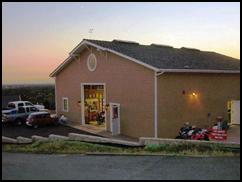 |
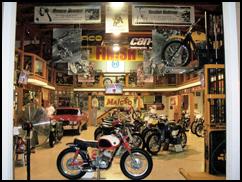 |
| Sun
sets over Tom's "garage/museum" |
Looking
though the front door to history |
 |
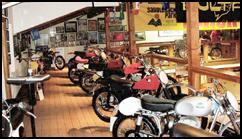 |
| How
many Huskies are enough Huskies? |
The
entire balcony is filled with motorcycles |
After his
experience of be co-Master of Ceremonies for the Dualies' organized
and sponsored On Any Sunday Reunion Movie/Fundraiser earlier this year,
Tom generously offered to host our October general meeting at his
museum, with his brother and friends cooking up the requisite Dualie
burgers, chili, chips and salad. After filling our faces and saying hi
to our friends and fellow Dualies, we repaired to the museum to get the
meeting business out of the way so we could feast our eyes on Tom's
fabulous collection.

|
 |
| Chowing
down on Dualie burgers with all the fixings on before going
inside for the show |
President Dave
Harlan kicked of the meeting by introducing Tom and his friends and
family, and then proceeded to make short work of the Dualies meeting
agenda. Also present were Dualie past president and founder, Larry
Langley, who gave us the status of his move up to Bass Lake, and CJ
Stewart who spoke to us about the OHV Volunteer organization that she is
try to start up in the Cleveland National Forest.
 |
 |
| President
Dave Harlan, CJ Stewart, and Larry Langley address the Dualies
membership |
Then it was
Tom's turn to speak to group and give us some background on all these
wonderful motorcycles and why he created this exquisite tribute to the
motorcycles of the golden age of motorcycling. He touched briefly on his
own personal history in the motorcycling business, his racing career,
and spoke about his heartfelt affection for this industry and those
wonderful two-wheeled machines. It's obvious that he can speak at
length and cite the dates, events, and people that played a part in
making the history of each bike.
 |
 |
| Tom
says a few words about his collection |
Conducting
a walk down memory lane |
In some ways, that
is the daunting part of writing this article. There is so much history
and interesting background in Tom's collection that it really deserves
a book, not just this humble article, to do the justice. With that in
mind, Tom and I have picked a few of the motorcycles that have special
meaning to him and will describe those in detail. For the others, you
will have to be satisfied with some pictures and brief captions.
One of the first
bikes that he spoke about was very unique twin-250 CC Husqvarna used to
win the Baja 1000. See below for the lowdown on this machine.
 |
 |
| The
centerpiece of Tom's Collection, one of three Husqvarna 500 CC
twins ever made |
Husqvarna
engineer, Ruben Helmin was a dedicated road racing enthusiast and with a
limited budget from Husky, developed a twin cylinder engine by combining
250cc Husqvarna motocross components with crankcases that he designed.
The development of
this engine sparked a predictable interest in extending the twin into
Husky's core business, the off-road business. The first dirt
version was handed over in late 1968 to Rolf Tibblin and later to
Torsten Hallman who raced it in a cross country race (with spiked tires)
and determined it was no motocrosser. In 1969, Husqvarna factory
rider Gunnar Nilsson won the European FIM cup motocross series, racing
against antiquated British 4-strokes. This 5-race series was FIM's
attempt to retain interest in the over 500cc bikes and at the time, the
twin was 504cc.
Edison Dye, the
American importer for Husqvarna had his own ideas for the machine.
He convinced the factory to build him a twin reduced to 499cc to
race in the now famous, Baja 1000. This bike, called the Baja
Invader was the only machine that was purpose built by the factory
for off-road and motocross, as the earlier bikes were modified for
off-road from road racing frames. Mr. Dye convinced the Husqvarna
factory to send over Gunnar Nilsson and then hired J.N. Roberts to
compete in the Baja on this machine. The pair led the race by a
significant margin until Nilsson crashed in the early hours of the
morning and was knocked senseless. It took him 20 minutes to find
the bike and he couldn't remember which direction he had been traveling
on the moon-like surface of the Baja course. Fortunately, he
guessed correctly and still ended up winning the race by 20 minutes.
The Twin was race
in a few more events and then sat for over 20 years in Edison's
warehouse. In 1998 it was purchased by Dutch enthusiast, Frans
Munsters who restored it to original condition. The Husqvarna
500cc Baja Invader now sits in Tom White's Early Years of MX Museum and
is one of only 3 twins ever built for off-road. Approximately 10
motors were built, most being used for road racing or side car racing.
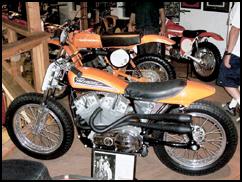 |
 |
| 250
and 750 Harley Dirt Bikes |
A
full list of the bikes takes two whole pages |
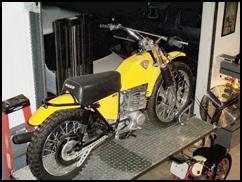 |
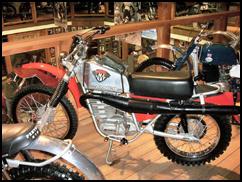 |
| The
king of the hill, Maico 500 Motocrosser |
A
Maico Enduro bike & Greeves leading link |
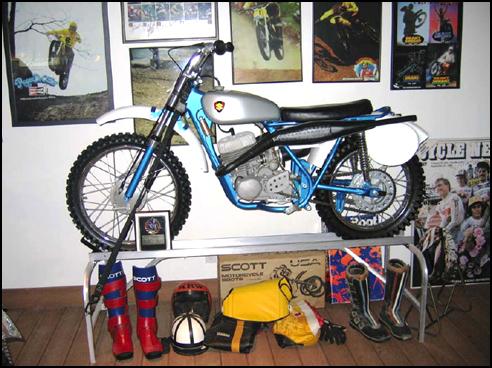 |
| One
of Tom's Top 3 favorites, 1968 Suzuki TM250 that started
Japanese domination of Motocross |
The next machine
is a 1968 Suzuki TM250. In 1965, Suzuki sent an engineer and one of the
factory road racers to Europe to test and develop a motocross bike. A
single cylinder and a twin cylinder machine were tested and they soon
decided to concentrate on the single cylinder model. It's important to
note that Suzuki was the first Japanese company to build a motocross
machine. The first machine, the RH66 stole many ideas from the CZ250
Twin Port as did the 1967 RH67 which was somewhat refined from the 66
model. The Europeans laughed at the early combination of a poorly copied
CZ and a road racer attempting to compete in the 250 GP's.
This would change
in late 1967 when Suzuki hired Ollie Pettersson to develop the bike and
later Joel Robert and Roger DeCoster to race the significantly improved
machines. The TM250 is based off of the RH67. This model is the first
production Japanese motocrosser and only 200 were produced World-wide,
with the US getting 65 in early 1968. The bikes were sold with a parts
kit that included a rod kit, pistons and rings, replacement clutch
parts, gearing and other items. The American Suzuki distributor hired
Gary Conrad, Preston Petty, and Walt Axthelm as riders to showcase the
new machine.
The early TM250
was hampered by it's heavy weight (235 lbs), peaky power, and poor
handling - not to mention the heat that was transferred to the riders
bottoms from the twin pipes. This machine is one of my top 3 favorites
in the collection. An excellent restoration by my friend Chris Carter of
Motion Pro and it being extremely rare, make it very special to me. I
can't tell you how excited I was when Chris and offered to sell me this
motorcycle.
 |
 |
| 3
flat screen TVs playing "On Any Sunday" |
A
TT 500 with 75 original miles |
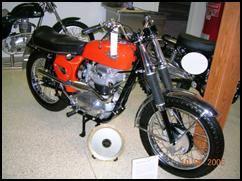 |
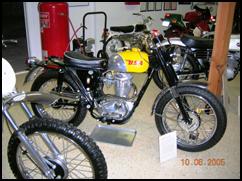 |
| Classic
British Iron, a Triumph twin desert sled and a BSA motocross
racer |
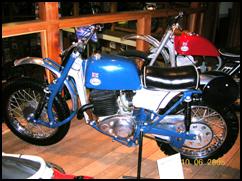 |
 |
| Several
Greeves with the Leading-Link Front Suspension and a Rickman
Triumph |
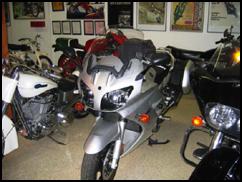 |
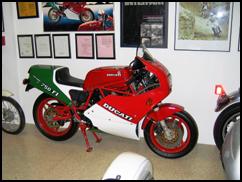 |
| Some
full dressers for the street set, and a vintage Harley, and
Ducati Road racer |
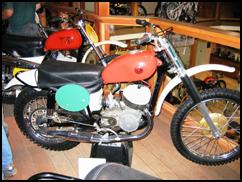 |
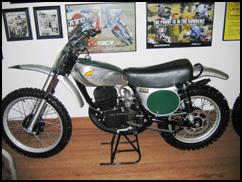 |
| A
250 and a 400 CZ motocrosser, plus a classic Honda 250 Elsinore |
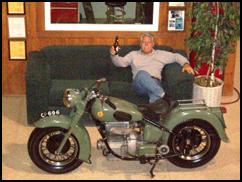 |
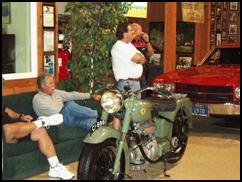 |
| Tom's
good friend, Bryan Farnsworth, sits in front of Sunbeam 500
Street bike |
The next bike is
actually a Sunbeam 500cc (actual 487cc) - S7 Sport, 1953. The
Sunbeam is a very unique air-cooled vertical twin (front cylinder in
front of rear cylinder, shaft drive motorcycle. The Sunbeam was
manufactured in the BSA plant and they were in business from 1947 to the
late 1950's. Top speed is in the 75 to 80 mph range, starts on
the first kick, and the lack of noticeable vibration assures a
comfortable ride. This example was purchased by Jody Weisels
(editor of Motocross Action Magazine - the number 1 MX magazine) father
while serving in the US military in England. He purchased the bike
and shipped it home to Texas. The machine has 13,263 original
miles and is in original, un-restored condition. The only
accessory is the rear fender rack.
 |
| A
classic Italian road racing machine, the 1952 Mondial |
The next bike is a
1952 Mondial, manufactured in Italy by a company started by the Bosselli
brothers. The first prototype, a 125cc dual overhead cam road race bike
built in 1948 was the basis for future racing machines. Mondial was
primarily a road race and street bike manufacturer. Only 7 or 8
motocross machines were ever produced, all 125cc machines. The Mondial
motocross machines won a single Italian championship in 1952 racing
against Moto Guzzis and Aeromachis. This 200cc machine (the only one
ever produced) was produced by a factory employee with the brother's
permission. Unfortunately, the Mondial factory went out of business in
1958.
This example was
restored by well-known Italian restorer, Edoardo Vannucchi in 2002 and
won best in class at the 2003 Del-Mar Concours.
When I first
approached Tom about writing an article on his collection/museum, I was
a little tentative about asking because I wasn't sure if he really
wanted word to get around about his treasures. When I sent him an email
asking whether I could write an article and if he would supply some
background on his favorite motorcycles, he soon put my concerns to rest.
"Ron, Heck
yes! I really want to share the motorcycles (and the history) with
people, so keeping the collection a secret (Greg Primm?) is not an
option. TW "
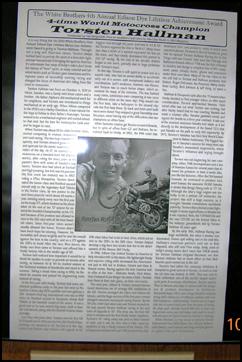 |
 |
| Examples
of the exciting visuals, articles and race posters that adorn
the wall |
 |
 |
| Tom
and his son, Brad, who was disabled in a disastrous motorcycle
accident |
Tom also shared
with us the story of his son, who was riding a mini-bike around one of
the original White Brother's warehouses and went around a corner at
speed, running into a chain use to block off a driveway. The chain hit
him mid-chest and slid up to his neck, crushing his Larynx, stopping his
heart for some minutes and causing severe brain damage. While he is
confined to a wheel chair, he is still very much a part of Tom's life
and an inspiration to us all.
Tom notes: "I
plan to have the museum open (look for an ad in Cycle News) by
appointment in early 2006. Current plans are the first Thursday evening
of every month will be "Bikes and Burgers Night" with all
profits going to my sons brain learning center, High Hopes Head Injury
Program. He attends classes at High Hopes four days a week and the
program has helped him (and many others) in so many ways. Unfortunately,
a lot of people don't have the resources that my family has (thanks to
the motorcycle business) to attend this wonderful program." Tom
hopes he can use his museum to change that.
|